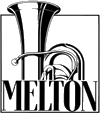Search
Frequently Asked Questions
What is the current value of my instrument?
Where can I purchase my Meinl-Weston instrument?
The Meinl-Weston / Melton Brand Names
In the unlikely case of a manufacturer’s defect: how do I proceed to claim the warranty and get the instrument repaired?
How can I safely take my Tuba with me on the airplane?
On my older instrument, there are red spots visible – what is it?
What is a 3B linkage system?
What is the current value of my instrument?
The value of a musical instrument can not be determined by the model and age only – playability and overall condition play an even more important role.
Considering this, it is easy to understand that no one has a chance to realistically comment on the value of a specific instrument from the distance without being able to physically inspect the instrument: chances are that repairs, overhauls and/or modifications were made by the previous owner(s) at some point – also, no one can comment on valve or slide action, dents or scratches or general wear and tear of the lacquer or plating from the distance.
Your local repair expert will be able to assist you and provide a detailed evaluation after inspecting your instrument physically and professionally.
Where can I purchase my Meinl-Weston instrument?
Meinl-Weston / Melton instruments and accessories are only sold through authorized agents.
Repair parts for Meinl-Weston / Melton instruments are available to authorized agents and authorized repair technicians.
Please contact your local distributor who can provide you with the address of an authorized Meinl-Weston / Melton agent nearest to you.
The Meinl-Weston / Melton Brand Names

Here we would like to explain the origins of our brand names – combined with some excerpts of the company’s history:
Up until the second world war, musical instruments in the bohemian-saxonian musical area were produced like sheet music, meaning that a manufacturer’s name was quite rare as an engraving on an instrument. Also there were so many Meinls in Graslitz and in the west after the war, that Anton Meinl decided to create a new brand name for the instruments made by the Wenzel Meinl GmbH – and that is how the name Melton, which means “Meinl tone” was born.
In 1957 the first Melton Logo was created including the line “Metallblasinstrumente”, translated: “brasswind instruments”. It was also planned that our own distribution company in the USA (later to be taken over by the Getzen company, see below) should use the same name. Unfortunately a flower company had registered the name Melton so a new name had to be thought out for the U.S.
It was a very happy gathering (including Bill Bell and Anton Meinl) at a round table where the name Meinl-Weston was created. By the way, there was never a Mr. Weston – in the times of the cold war the name Meinl-Weston was chosen to indicate that this was truly a product of the west, so as to draw a clear line with the competition from the east, where companies previously owned by our fathers had been taken over by the state in communist times.

It wasn’t until the 1980’s when the Melton Logo received a new design – again employing the image of the Tuba. (the Tuba on the logo by the way is our model 25) and at the same time, a similar logo was created for Meinl-Weston to emphasize the same identity, although the brand names, marketing and logos were always used separately until the 1990’s. Instruments for Europe, Australia, Korea and Taiwan are engraved with Melton, instruments for the U.S. and Japan and several other countries are engraved with the Meinl-Weston name.

In the late 1990’s, as the world got smaller, the separate usage of both brand names obviously created some confusion amongst the travelling musicians. As a reaction to this, the two brand names of Melton and Meinl-Weston were put together side-by-side for all publications of the Wenzel Meinl GmbH to emphasize that the only difference in the different brands is the engraving, nothing else You can expect the same playing qualities whether it is a Meinl-Weston or a Melton instrument!

Since 2009, all Instruments are engraved with the newly designed combined Melton Meinl Weston Logo.
By the way – on some older instruments within the U.S., you might still find the sub-title “A Division of Getzen” under the Meinl-Weston engraving on the bell, and here is why: When the Getzen company took over the distribution of Meinl-Weston in the USA in the late 1960’s, they added that sub-title. Although the Wenzel Meinl GmbH was never a department of the Getzen company, (Meinl-Weston was merely one of the products which they distributed) the synergies and friendship between the two companies lasted throughout various owners of Getzen and continue still today.
In the unlikely case of a manufacturer’s defect: how do I proceed to claim the warranty and get the instrument repaired?
(For warranty content, please see the user and warranty information booklet that is accompanied with each instrument)
Always immediately contact the dealer where you have purchased your instrument. They will handle the warranty for you and determine which steps are necessary to fix the problem in close cooperation with us.
With each and every warranty claim the serial number (to be found on the leadpipe receiver) must be provided.
Any repair must be approved by the manufacturer prior to being executed – or you risk voiding the warranty.
For obvious reason, damages due to improper use of the instrument, lacking care and maintenance and unauthorized repairs are not covered by the manufacturer’s warranty.
How can I safely take my Tuba with me on the airplane?
Our recommendation for airline travel is to always use a flight case that is custom fitted to your instrument.
The accepted maximum dimensions and/or weight can vary with each carrier – contact your airline (best prior to booking) for detailed information and applicable charges. Note that depending on your booking class and/or status with a certain airline, you might have a higher baggage allowance and/or a lower or even no additional fee.
Here is a link we recommend to check for further insight information and experiences others have already made:
“Flying with a Tuba” -thread on Sean Chisham’s Tubenet
For the day of travel, plan to be early for check-in so you have enough time, especially to ensure your Tuba also passes security inspection safely. TSA encourages you to stay with your instrument while security officers screen it (to make sure it is repacked properly!).
If you have to travel on short notice without having a flight case, you might want to consider borrowing a Tuba, (best your model) at your destination instead of risking damage upon arrival: there are several Tuba forums within the Tuba community where you can post a request; Facebook could be of use for this as well.
Safe travels!
On my older instrument, there are red spots visible – what is it?
This is most likely a so-called “red dot”, a copper hole. Constant exposure of moisture – for example when the instrument after playing not drying – after a long period leads to dezikinfication. That means the zinc is removed from the connection material and the red dot is left behind. The effected part must be replaced. With a little care this is easy to avoid.
Please see also our care instructions.
Incidentally, gold brass (and silver) is largely resistant to dezikinfication.
What is a 3B linkage system?
In contrary to the existing linkages, the new 3B linkage system uses two stell balls in bronze ball bearings for each valve in order to optimise the transmission: one ball connects the valve action rod to the bottom of the lever, the other one is connected to the stop arm.
3B stands for “Bronze Ball Bearing”, or in other words for a steel ball that is held within a bronze bearing. Additionally to this perfect gliding combination of steel and bronze, a spring on the connector to the valve action rod keeps the linkage in an optimal position to guarantee a perfectly smooth moving. In the end, it feels not much different to a string mechanism rotary valve.